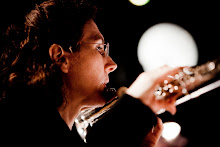This is a continuation of my previous post, where I use Taffanel/Gaubert's Exercises Journaliers no. 1 to practice polyrhythms. Check that out before trying these! It will give you the correct placement in the measure for 4:3 and 4:5, which I have not notated here.
In these exercises, the metronome stays the same but the player has to change gears. I like to use this as an articulation exercise. You can shift from single tonguing to double tonguing as the tempo changes (but the metronome doesn't). It keeps you on your toes.
Set your metronome to a 3-beat pattern. The suggested tempo is a quarter note=45 but you can start slower if it helps. You'll need to start on the third beat for this to come out right. I love the fact that this pattern gives you an added rest for breathing!
The following variation puts the polyrhythm first. If you are doing this as an articulation exercise, it is good to start with double tonguing and then go to single tonging. I find this shift to slower tonguing more challenging.
Here is another variation going against a 5-beat pattern. Set your metronome to reflect that, at quarter note=75 (or slower if that helps). For this to come out right, start on the second beat. (This pattern gives you an eighth note for breathing, hooray!)
And here, a variation starting with the polyrhythm.
I hope these exercises will be of some use. Please post a comment if you have questions. I have had various comments regarding the notation of these exercises. There are more detailed ways of notating them but I find the notation above gets the concept across. In the end, you don't need the notes to perform the exercises. My goal in this was to use melodic material to develop a sense of rhythmic phrasing.
Monday, October 17, 2011
Monday, October 10, 2011
Polyrhythm III Exercise with Taffanel/Gaubert
Here is the third of my posts on rhythm. You can read the first post here and the second here. I wouldn't proceed here unless you can perform the exercises of these previous posts.
What I like about using Taffanel/Gaubert no. 1 from Exercices Journaliers is that it is a melodic study. In my first post, I emphasize the need for rhythmical phrasing, and the goal of playing rhythmically and not mechanically. One way of developing this, I think, is to develop your own strong, steady sense of pulse. This is something different from practicing with a metronome. If you test and develop your sense of pulse against the metronome's ticking, it will grow stronger.
If you take the basic 4-beat pattern of TG no. 1 and set your metronome to a 3-beat pattern at tempo 45, it could fit together like this:
And if you take the basic 4-beat pattern and set your metronome to a 5-beat pattern at tempo 75, it could fit together like this:
You may have noticed that in both examples the 16ths are the same speed, only the metronome setting is different.
An interesting way to practice Taffanel Gaubert nos. 1 and 2 is to first play with the metronome at a quarter note = 120. Play a number of patterns until you feel comfortable with the speed, then continue but change the metronome to a quarter note = 45 and play the 4:3 pattern. When you feel comfortable with that, change the metronome to a quarter note = 75 and play the 4:5 pattern.
This is a wonderful way of practicing groove!
In my next post, I will use these same sort of exercises to practice tempo modulation.
What I like about using Taffanel/Gaubert no. 1 from Exercices Journaliers is that it is a melodic study. In my first post, I emphasize the need for rhythmical phrasing, and the goal of playing rhythmically and not mechanically. One way of developing this, I think, is to develop your own strong, steady sense of pulse. This is something different from practicing with a metronome. If you test and develop your sense of pulse against the metronome's ticking, it will grow stronger.
If you take the basic 4-beat pattern of TG no. 1 and set your metronome to a 3-beat pattern at tempo 45, it could fit together like this:
And if you take the basic 4-beat pattern and set your metronome to a 5-beat pattern at tempo 75, it could fit together like this:
An interesting way to practice Taffanel Gaubert nos. 1 and 2 is to first play with the metronome at a quarter note = 120. Play a number of patterns until you feel comfortable with the speed, then continue but change the metronome to a quarter note = 45 and play the 4:3 pattern. When you feel comfortable with that, change the metronome to a quarter note = 75 and play the 4:5 pattern.
This is a wonderful way of practicing groove!
In my next post, I will use these same sort of exercises to practice tempo modulation.
Sunday, October 9, 2011
Polyrhythm II
To internalize an unfamilar polyrhythm, I suggest the following steps:
1) clap and tap the rhythm away from your instrument
2) play it on your instrument, using a single pitch (no moving notes yet)
3) if it's a difficult passage, play it using simplified material (a simple scale pattern)
4) play as written
Here is a written-out variation on how you can practice a scalar passage 5:4.
Your first step (not shown here) could be to play repeated sixteenths (here, it would be repeated F's) and accent every 5th one.
The first line shows how groups of 5 sixteenths fit into a 5/4 bar.
The second line fills in the ties with moving sixteenths.
The third and fourth lines are played the same but notated differently. It's good to practice both.
When you have an even number against 3, I find it easy to feel or visualize the second half of the second beat. It serves as a goal-post, or check-point. Here is an exercise similar to that above, but with 4:3.
Remember, your first step (not shown here) could be to play repeated sixteenth F's and accent every 3rd one.
Here are some further exercises with even numbers against 3. If it helps, focus on the back of the second beat.
In the next post, I will take the scale patterns from Taffanel/Gaubert and fit them into a polyrhythmic pattern.
Saturday, October 8, 2011
Polyrhythms I
Why bother practicing polyrhythms? Some of us have been taught that our metronome is our best friend, but how useful is it really? Do we bother to listen to it? If we do, does it ensure us a good sense of rhythm? If some of us were honest, we would admit that we do not want to listen too closely, for fear of being labeled mechanical. After all, we want to play rhythmically, not mechanically. How to do this?
What I suggest is a method to develop rhythmical phrasing through the study of Taffanel/Gaubert's study no. 1 from Exercices Journaliers. (I choose this because most of you reading this are flutists, and it is best to apply these ideas to something that is already familiar.). But this introduction will first cover the basics.
A well developed sense of rhythmical phrasing can help whether you want to become the next star beat-boxer or want to keep a steady Scherzo from Mendelssohn's A Midsummer Night's Dream.
You will need a metronome that can be set to a simple beat pattern (2/4, 3/4, etc.), and a willingness to feel a bit clumsy at first.
The following examples use simple mathematics to see visually where your pulse is against the metronome's (or your partner's). It is a graphical guide to help develop a FEEL for the polyrhythm.
Given polyrhythm a:b, where b = metronome beats and a = your beats, there are two ways of figuring it out:
1) Take the b number of metronome beats and divide it into units of a, then clap or play every b number of these units. Let's take the example where a:b = 3:2 (three against two). In standard notation it looks like this:
Now take two (b) metronome beats, divide them into units of three (a),
Now clap or play every two (b) of these units as shown by a crossed note head:
2) The second way to figure a:b is to multiply a times b, in this case 3 times 2. This gives us six:
Now divide this 6 into a (3). That gives us two, so mark every two pulses with an O on top. Then divide 6 into b (2) . This gives us 3, so marks every 3 pulses with an X on the bottom.
The "O"s are the rhythm you play or clap, the "X"s are the metronome beats.
Here is a more complicated example: 5:7
Let's see how it looks using the first method: given a:b, divide b (7) into units of a (5) :
Now clap or play every b of these units (7) notated by a crossed note head:
Try writing this example using the second method. (Begin by multiplying 5 x 7.)
The next installation will give practical exercises on how to feel 5:4, and any even number against 3.
For more practice, see Peter Magadini's Polyrhythms, the Musician's Guide, Hal Leonard Publications, 1993
If you would like a pdf of this information in English or German, please leave a comment.
Read the next installation here.
Subscribe to:
Posts (Atom)




















